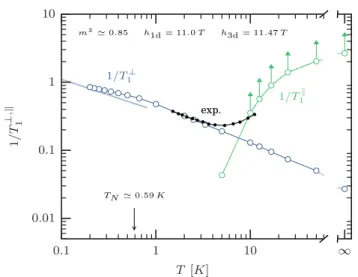Temperature dependence of the NMR relaxation rate $1/T_1$ for quantum spin chains
Texte intégral
Figure
![FIG. 1. (color online) (i) Upper panel : magnetization curve of the XXZ Hamiltonian (2.1) as a function of the magnetic field for ∆ ∈ (−1, 1]](https://thumb-eu.123doks.com/thumbv2/123doknet/14401321.510070/3.918.480.836.75.453/color-online-upper-panel-magnetization-hamiltonian-function-magnetic.webp)



Documents relatifs
Abstract. The moments of the total number of metastable states and the typical number of metastable states at a given magnetization are calculated. there is an
Brief review of ultracold spin-1 gases. At very low temperatures, Bose–Einstein condensation leads to a macroscopic occupation of a single-particle state Ψ, a superposition of all
Using results on the mass gap in the sine-Gordon model combined with the exact amplitudes in the bosonized representation of the Heisenberg spin-1/2 chain and one-loop
On the other hand, if one thinks that solving an integrable model means that one is able to reduce the complexity of the system using unified mathematical structures (quantum
The class containing just isotropic Heisenberg and biquadratic exchange is particularly interesting be- cause as well as the model studied by Haldane, it con- tains
- A variant of the quantum transfer-matrix method is used to obtain numerically accurate results for the specific heat of an easy-plane spin chain with an
The improvement is achieved by optimizations on three aspects of the existing proofs in section 2, we present an improved variant of the Dyson- Lieb-Simon [2] (DLS) proof, in section
At the moment, one knows how to calculate the number of metastable states and the sizes of their basins of attraction for a one-dimensional spin glass at zero temperature